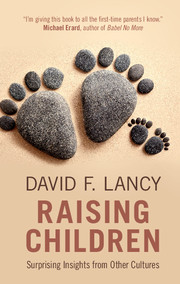
-
Select format
-
- Publisher:
- Cambridge University Press
- Publication date:
- 05 July 2017
- 05 June 2017
- ISBN:
- 9781108227629
- 9781108415095
- 9781108400305
- Dimensions:
- (216 x 138 mm)
- Weight & Pages:
- 0.42kg, 220 Pages
- Dimensions:
- (216 x 138 mm)
- Weight & Pages:
- 0.32kg, 220 Pages
- Subjects:
- Social and Cultural Anthropology, Anthropology
You may already have access via personal or institutional login- Subjects:
- Social and Cultural Anthropology, Anthropology
Book description
Why in some parts of the world do parents rarely play with their babies and never with toddlers? Why in some cultures are children not fully recognized as individuals until they are older? How are routine habits of etiquette and hygiene taught - or not - to children in other societies? Drawing on a lifetime's experience as an anthropologist, David F. Lancy takes us on a journey across the globe to show how children are raised differently in different cultures. Intriguing, and sometimes shocking, his discoveries demonstrate that our ideas about children are recent, untested, and often contrast starkly with those in other parts of the world. Lancy argues that we are, by historical standards, guilty of over-parenting, and of micro-managing our children's lives. Challenging many of our accepted truths, his book will encourage parents to think differently about children, and by doing so to feel more relaxed about their own parenting skills.
Reviews
‘If you've ever wondered why you are sitting on the toy-strewn floor, playing a third game of Candyland, so bored you are ready to hang yourself with a Slinky, Dr Lancy has the answer. It's the culture, not you.'
Lenore Skenazy - founder of the book, website, and movement, Free-Range Kids
‘David F. Lancy's fascinating and comprehensive work on the anthropology of childhood puts modern Western parenting into much needed historical and cultural context, calling into question all that we assume to be best practice or most ‘natural'. In an age of unprecedentedly high parental anxiety, Lancy's work offers compelling, welcome evidence that there truly are many ways to raise a thriving child.'
Christine Gross-Loh - author of Parenting Without Borders and co-author of The Path
‘Dr Lancy exhibits an all-too-rare talent in the academy: the ability to synthesize an impressive array of scientific data in an easy-to-read, even delightful, manner. What makes Raising Children: Surprising Insights from Other Cultures particularly rewarding is its broad scope, weaving stories from scores of cultures across time and space, coupled with its intriguing focus. Readers who explore the universe of child-rearing techniques will gain insights not only into the human animal, but their own children as well.'
Michael S. Sweeney - author of Brain: The Complete Mind
‘David F. Lancy has written a compelling compendium of cultural differences in child care philosophy and child rearing practices. He clearly demonstrates that the Western (middle class) views and practices, which are offered in textbooks as the normal and healthy way, are at best an outlier in the world wide spectrum. David F. Lancy says it is a book about parents, but it is also a book for parents, especially for Western middle class parents which would help them relax and rely more on their intuitions. It is moreover a must for health care professionals and educators who deal with multicultural realities. It can help to prevent damage based in lacking knowledge and awareness of the contextual nature of any developmental processes.'
Heidi Keller - author of Cultures of Infancy
'I'm giving this to all the first-time parents I know.'
Michael Erard - author of Babel No More
'Lancy’s research is so thorough and his writing infused with such gentle humour that even his admonishments and one-liners to parents are a pleasure.'
Shaoni Bhattacharya Source: New Scientist
Contents
Selected Sources
Chapter 1: Leave the Kids Alone
Chapter 2: Culture and Infancy
Celebrating Babies
What about Swaddling?
There Was an Old Woman …
Chapter 3: Questions about Infant Attachment
Detachment Parenting
Babies Aren’t People
Devils or Angels?
“Baby-Parading”: Childcare or Showing Off?
Chapter 4: Children Playing and Learning
Cowboys and Indians and the Origin of the Couch Potato
Toys or Tools?
Gamesmanship
Chapter 5: Protection versus Suppression
Nanny Angst
Child-Proofing versus Tool Using
What Price Happiness?
Turning Inside Out Inside Out
Chapter 6: Going to School
The Resistant Scholar: Don’t Blame Teachers, Schools, Curricula, or Television
The Roots of Schooling: Learning Must Be Paid For with Effort, Suffering, and Pain
Coercive Pedagogy: When “Education” Means Compliance
Of Course “Good” Teaching Is Rare—Why Should We Expect Otherwise?
Talking like a Book
Chapter 7: The Consequences of Raising “Unique Individuals”
What’s in a Name?
Trash Talking or Taking Out the Trash
Failure to Launch
Chapter 8: Summary and Speculation
Gazing into the Crystal Ball
Chapter 9: The Backstory
Metrics
Altmetric attention score
Full text views
Full text views help Loading metrics...
Loading metrics...
* Views captured on Cambridge Core between #date#. This data will be updated every 24 hours.
Usage data cannot currently be displayed.
Accessibility standard: Unknown
Why this information is here
This section outlines the accessibility features of this content - including support for screen readers, full keyboard navigation and high-contrast display options. This may not be relevant for you.
Accessibility Information
Accessibility compliance for the PDF of this book is currently unknown and may be updated in the future.


